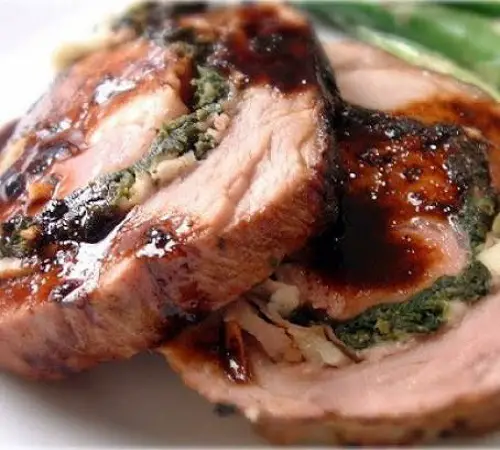Roast Loin of Pork with Fig Preserves
Roast Loin of Pork with Fig Preserves


Ingredients
for the brine
-
½ tbsp table salt per cup of liquid used. If using kosher salt, ¾ tbsp per cup of liquid.
-
¼ tbsp (brown) sugar per cup of liquid used.
-
1 pint (16 0z, 473 ml) apple cider
for the roast
-
1 pork loin, butterflied in thirds (see images below)
-
½ to 1 cup fig preserves with balsamic vinegar
-
¼ lb (112 g) pancetta, thinly sliced
-
rosemary, chopped
-
olive oil
-
salt & pepper
-
Yukon Gold potatoes, washed and cut into equally sized chunks
-
2 garlic cloves, diced or grated
-
water, white wine, and stock (vegetable or chicken)
Directions
The Night Before
-
Carefully butterfly the pork loin 3 ways. Your butcher will do this for you. Otherwise:Divide the roast’s thickness into thirds. The first cut will be ⅓ of the way down from the top. Be careful not to cut through the meat. The object is to create a flap not a separate piece
-
Use your knife to cut the thicker portion in half, again creating a flap and not separate pieces. (Click image on left to see how it is done.)
-
Following the guidelines, mix enough of a brining solution to ensure that the roast is completely immersed. Select a large enough non-reactive pot, bowl, or sealable bag to make this possible. If need be, place a plate on top of the roast to keep it submerged. Place everything in the refrigerator.
Do not brine longer than 8 hours.
That Morning
-
Combine enough olive oil, rosemary, salt & pepper to coat both the roast’s exterior and the potatoes. Mix well and set aside.
-
Remove the pork from the brine, rinse it under tap water, and pat dry.
-
Open the roast and use the fig preserves to fully coat its inside.
-
Close/roll the roast, cover with marinade, and set aside.
-
On a clean work surface, spread a sheet of plastic wrap large enough to fully encase the rolled roast.
-
On top of the plastic wrap, place 4 or 5 pieces of butcher’s twine that are long enough to tie the roast.
-
Place the pancetta pieces atop the twine, making one large sheet. Use a pastry brush to coat the pancetta with the marinade.
-
Place the roast onto the pancetta and roll it, as you would a jelly roll, to completely cover it in pancetta. Tie the twine to secure the roast.
-
Coat the roast with olive oil before wrapping it in the plastic wrap. Place in the refrigerator until 30 minutes before the roasting is to begin. Refrigerate at least 1 hour, preferably several.
To Roast
-
Pre-heat oven to 400˚ F (204˚ C)
-
30 minutes before you start to roast the pork loin, remove the meat from the fridge and set aside.
-
Place potatoes in a large bowl, add reserved marinade, add garlic, and mix until well-coated. Place in a roasting dish/pan.
-
Unwrap the pork loin and place it on a rack in the center of the roasting pan. Add 1 cup of water to the pan. (See Notes.)
-
Place pork roast in the center of the oven.
-
15 minutes later place the potatoes on the same rack or above. Check the pork’s pan drippings and augment with stock and/or wine, if necessary. Repeat every 10 to 15 minutes, as needed. Do not allow to dry completely.
-
After 20 minutes, use a large spoon to rearrange the potatoes.
-
Roasting time will vary depending upon the size and cut of your roast. Begin checking the temperature of a 4 lb. roast after 45 minutes. For medium rare, a temperature of 145˚F (63˚ C) is required. Remember, the roast will continue to cook as it rests.
-
When the desired temperature is achieved, remove the roast, tent with aluminum foil, and allow to rest for at least 10 minutes.
-
If potatoes are roasted to you liking, remove and tent to keep warm.
-
If desired, strain the pan’s juices, separate the grease, and
-
serve as-is
-
heat in a pan over med-high heat to reduce
-
use a couple tbsp of the grease with an equal amount of flour to make a roux. To that roux, add the separated pan juices and additional wine or stock, as needed to make a gravy.
-
-
Check for seasonings.
-
After the roast has rested, remove the strings, slice, and serve immediately with the potatoes and sauce.
* * *
Notes
The brining ingredients as listed take into account that the roast was butterflied before it was brined. If you decide to butterfly it after brining you’ll need to double the amounts of sugar and salt used. That’s simply because a whole roast has less surface area than one that’s been butterflied.
No matter how you “wrap” the roast, a little — or a lot — of the fig preserves are going to spill into the roasting pan. Because of their high sugar content, the preserves will burn pretty quickly once they hit the hot pan. With a little care, however, they can help make a great sauce. The key is to make sure the roasting pan never dries completely. Here I started with a cup of water since its purpose was to keep any preserves from burning. As the roasting progressed, I switched to a combination of wine (California Riesling) and stock, ensuring a more flavorful sauce.
This site contains product affiliate links. We may receive a commission if you make a purchase after clicking on one of these links.


